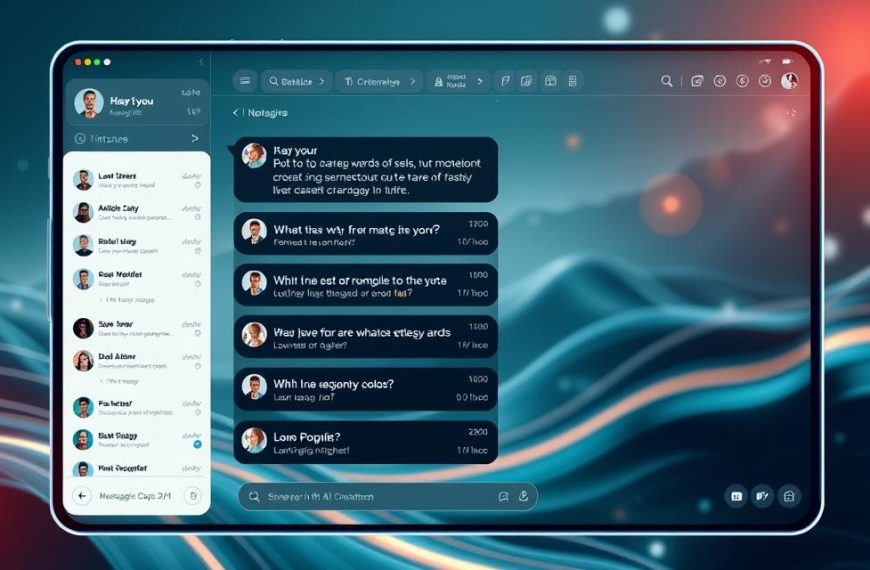Artificial intelligence has moved from science fiction to real business strategies. Now, over 55% of companies use artificial intelligence business applications every day. This change shows how technology is changing how businesses compete and make money.
Finance and healthcare are leading this change. They use machine learning to predict market changes and improve patient care. Retail and manufacturing also use AI to make their operations better.
The use of enterprise AI adoption is growing fast, at 38% a year. Companies that use AI well are 23% more profitable. This shows why 72% of US business leaders see AI as key to success.
AI tools are making businesses more efficient and better at serving customers. The big question is how fast companies can change to use these disruptive capabilities well.
The Evolution of AI Adoption in Modern Enterprises
AI adoption in businesses has changed a lot. It’s now about changing how businesses work, not just automating tasks. Companies like TD Bank started using AI for customer service in 2022.
From Automation to Cognitive Systems
Early-stage robotic process automation was the start of AI in businesses. At first, it was used for tasks like processing invoices. This made businesses 30-50% more efficient, as Business News Daily found.
These systems got smarter when they were combined with machine learning. This made them more than just automated tools.
Then, businesses started using ML for harder tasks. Microsoft’s 2024 Work Trend Index showed 68% of US companies use AI for predictive maintenance. This change helped them manage operations better, not just react to problems.
“Cognitive AI doesn’t just execute commands – it anticipates business needs through pattern recognition”
Key Drivers for AI Implementation
There are three main reasons why businesses adopt AI:
- Market pressure from digitally-native competitors
- Exponential growth in structured/unstructured data
- Regulatory demands for real-time compliance monitoring
Competitive pressure in digital transformation
Financial institutions like Société Générale use AI for agentic AI solutions. They want to stay ahead in the market. Their strategy cut down customer query times by 40% in 18 months.
Data explosion and analysis requirements
The IMF’s 2024 report says 40% of jobs now use AI for data processing. Today, businesses deal with 2.5x more data than in 2020. They need advanced AI for insights.
Core Applications: How AI is Being Used in Business
Artificial intelligence is key to modern business strategies. It changes how we interact with customers and manage our supply chains. This section looks at three main areas where AI makes a big difference.
Customer Experience Transformation
Companies are now using AI to anticipate customer needs instead of just reacting. This approach leads to more meaningful interactions and less hassle.
Chatbots and Virtual Assistants
Today’s chatbots do more than just give answers. HubSpot’s CRM shows how AI can solve 68% of customer queries on its own. Samsung’s Galaxy S24 uses deep learning to adjust how it talks to users based on their habits.
Personalised Marketing Engines
Synthesia’s video platform is a great example of AI making content personal. Flybits’ banking shows how AI can give users financial advice that’s just for them, leading to a 40% increase in sales.
AI-Driven Operational Efficiency
AI helps businesses save money by automating processes. It uses data from sensors and predictive analytics to manage resources better.
Predictive Maintenance Systems
Studies show that predictive maintenance AI can cut equipment failures by 55%. It spots problems early, allowing for planned downtime and less lost production.
Intelligent Supply Chain Optimisation
Nara Logics’ restaurant uses AI to keep inventory right. It cuts food waste by 28% and keeps menus full, showing AI’s power in managing resources.
Decision Support Systems
AI tools are becoming essential for business leaders. They turn complex data into clear insights, helping with planning and risk management.
Real-Time Analytics Dashboards
Today’s business intelligence updates fast, every 15 seconds. This lets managers see trends as they happen, not after the fact.
Risk Management Prediction Models
Financial firms use risk modelling algorithms to check creditworthiness. They look at 127 variables in a flash, making loans safer and reducing defaults by 19%.
| AI Type | Business Application | Impact Metric |
|---|---|---|
| Machine Learning | Customer Service Automation | 68% Query Resolution |
| Deep Learning | Predictive Maintenance | 55% Failure Reduction |
| Neural Networks | Supply Chain Optimisation | 28% Waste Decrease |
Industry-Specific AI Implementation Trends
Artificial intelligence is changing industries in unique ways. It’s bringing new solutions to retail, healthcare, and finance. From predicting what we’ll buy to speeding up drug development, AI is making a big difference. Let’s look at how AI is changing three key sectors.
Retail Sector Innovations
Retailers are using retail AI forecasting to guess what we’ll buy. For example, Amazon’s recommendation engines look at 45 billion data points every week. This helps them manage stock better in their global warehouses.
Demand forecasting algorithms
Now, machine learning models can handle lots of data at once. They look at weather, social media, and past sales. This helps retailers cut down on stockouts and save money on too much stock. ASOS, for instance, saw a 22% better supply chain after using these systems.
Visual search technology adoption
Sephora’s AI chatbot lets users find products by uploading photos. But, research from Carnegie Mellon University shows AI can be biased. It found gender bias in job ads made by similar AI systems.
Healthcare Advancements
The NHS is using medical imaging AI to change healthcare. Doctors using AI tools can spot tumours in breast cancer scans 40% faster.
Diagnostic imaging analysis
AI systems compare patient scans with global databases in real time. This cut down diagnostic mistakes by 28% in a trial at Oxford University Hospitals last year.
Drug discovery acceleration
NVIDIA’s BioNeMo platform is used by 90% of top pharma companies. It makes drug development much faster. Recently, it found Alzheimer’s treatment candidates in just 46 days, a big improvement over the usual 18 months.
Financial Services Transformation
JPMorgan’s COiN platform handles 12,000 complex contracts every hour with algorithmic trading systems. This shows how finance is being transformed by AI. It saves a huge amount of time compared to manual work.
Fraud detection systems
AI systems check transaction patterns across 200 variables at once. According to Investopedia, American Express saw a 63% drop in false positives after using these systems. This saved them £1.2 billion a year in fraud costs.
Algorithmic trading platforms
Now, 70% of NASDAQ transactions are done by high-frequency trading algorithms. They react to market changes in 0.0001 seconds. Goldman Sachs’ MARX platform shows AI can beat human traders by 8.7% in volatile markets.
| Industry | Key AI Applications | Measurable Impact |
|---|---|---|
| Retail | Demand forecasting, Visual search | 35% inventory cost reduction |
| Healthcare | Medical imaging, Drug discovery | 40% faster diagnoses |
| Finance | Fraud detection, Algorithmic trading | £1.2B annual fraud savings |
AI is changing industries in different ways. While there are concerns about data privacy and bias, the benefits are clear. Companies that don’t use AI risk being left behind in today’s fast-paced market.
Challenges in Business AI Integration
The journey to integrate AI is filled with challenges. These include moral dilemmas and outdated systems. Companies must innovate responsibly and tackle technical and workforce gaps.
Ethical Considerations
Almost 42% of people doubt AI decisions, a 2023 MIT survey found. This distrust grew after scandals like Sports Illustrated’s AI author issue. It showed the risk of fake content.
Bias Mitigation Strategies
Companies fight bias with AI ethics frameworks like Adobe’s Content Authenticity Initiative. These systems track data origins and ensure diversity in training. IBM’s Fairness 360 Toolkit also audits AI fairness across different groups.
Privacy Protection Frameworks
EU GDPR fines in 2022 reached €1.6 billion, showing the need for compliance. Top companies use hybrid data models:
- Anonymisation engines for customer insights
- On-premise AI for sensitive data
- Blockchain for consent tracking
Implementation Barriers
Microsoft’s 2024 SMB survey found 67% lack AI skills in-house. This gap is worsened by outdated systems in 58% of companies.
Skills Gap in Workforce
Effective workforce reskilling programmes use microcredentials and labs. Amazon’s Machine Learning University has upskilled 300,000 employees. Partnerships with Coursera and Udacity help fill knowledge gaps affordably.
Legacy System Compatibility Issues
Many banks use 40-year-old COBOL systems, making AI integration hard. Legacy modernisation challenges need a phased approach:
- Containerisation of core applications
- API gateway deployment
- Gradual cloud migration
| Challenge | Impact | Mitigation Strategy |
|---|---|---|
| Algorithmic Bias | Erodes customer trust | Ethical AI certification programmes |
| Data Privacy Risks | Regulatory penalties | Federated learning systems |
| Technical Skills Shortage | Project delays | Vendor-managed training ecosystems |
| Legacy Technical Debt | Integration failures | Middleware adoption |
Addressing these challenges requires a unified effort. This includes updating AI ethics frameworks and investing in workforce reskilling programmes. Companies that tackle both ethical and technical barriers will lead in AI adoption.
Future Projections for AI in Business
As we move towards 2030, AI’s role is changing. It’s no longer just about making things work better. It’s about changing how businesses work altogether. The International Monetary Fund says 60% of advanced economies will see big changes in their workforces because of AI.
This change is based on two main areas: technology convergence and human capital adaptation.
Emerging Technologies Convergence
AI is teaming up with other technologies in new ways. For example, Samsung is working on 3D interfaces, and Microsoft is teaming up with OpenAI. These partnerships are creating new possibilities.
AI-Blockchain Integration
Companies are combining AI’s ability to predict with blockchain’s security. This mix is making things like:
- Tamper-proof supply chain analytics
- Decentralised decision-making protocols
- Real-time fraud detection systems
Quantum Computing’s Promise
Investments in quantum-ready infrastructure have tripled, says Curation Zone’s GPU market analysis. Early users are looking at quantum AI applications for:
- Molecular-level drug discovery
- Hyper-personalised financial portfolios
- More accurate climate pattern simulations
Workforce Evolution
McKinsey’s study found 71% of employees trust AI for routine tasks now. This is a 23% jump from 2021. It shows we need to plan our workforces carefully.
Human-AI Collaboration Models
MIT suggests human-machine teaming. This means:
- AI does data-heavy tasks
- Humans solve creative problems
- Together, they handle ethical issues
“The future belongs to companies that champion cognitive diversity – human intuition amplified by machine precision.”
Reskilling Initiatives
Good corporate reskilling strategies focus on:
- Teaching AI literacy to top leaders
- Upskilling in digital skills across departments
- Teaching ethics to AI developers
Shaping Tomorrow’s Enterprise Landscape with AI
Businesses must choose to adapt to AI or risk being left behind. The success of AI-driven companies shows how lean operations can grow fast. Some companies reach $100M in revenue with teams under 50, changing what we see as success.
Using AI responsibly means finding a balance between new ideas and rules. The Biden administration and the World Economic Forum have set guidelines for ethical AI use. Companies need to keep up with these rules while staying flexible, a big challenge with AI’s quick changes.
Good AI strategy involves three key areas: automating tasks, improving decision-making, and engaging customers better. Retailers use chatbots for help any time, healthcare speeds up finding new drugs, and banks reduce risks with AI. These examples show AI’s power to change and help in many fields.
Companies that work with IE University’s model get ahead. They see how combining human skills with AI boosts profits. Those that focus on learning and adapting will lead the future, turning today’s problems into chances for growth.

















